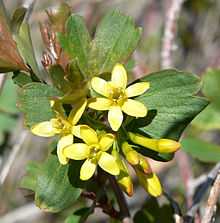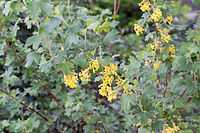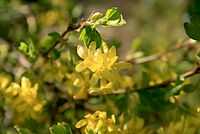Ribes aureum
| Ribes aureum | |
|---|---|
 | |
| Ribes aureum var. aureum, Spring Mountains, Nevada. | |
| Scientific classification | |
| Kingdom: | Plantae |
| (unranked): | Angiosperms |
| (unranked): | Eudicots |
| (unranked): | Core eudicots |
| Order: | Saxifragales |
| Family: | Grossulariaceae |
| Genus: | Ribes |
| Species: | R. aureum |
| Binomial name | |
| Ribes aureum Pursh | |



Ribes aureum, known commonly as the golden currant, is a species in the genus Ribes.[1] It is native to Canada, most of the United States (except the southeast) and northern Mexico. The species[2] Ribes odoratum is closely related, and sometimes named Ribes aureum var. villosum.[3]
Description
Ribes aureum is a small to medium-sized deciduous shrub, 2–3 metres (6.6–9.8 ft) tall. Leaves are green, shaped similarly to gooseberry leaves, turning red in autumn.
The plant blooms in spring with racemes of conspicuous golden yellow flowers, often with a pronounced, spicy fragrance similar to that of cloves or vanilla. Flowers may also be shades of cream to reddish, and are borne in clusters of up to 15.[4] The shrub produces berries about 1 centimeter in diameter from an early age. Ripe fruits, amber yellow to black in color, are edible raw, but very tart, and are usually cooked with sugar. The flowers are also edible.[4]
Varieties
- Ribes aureum var. aureum (< 3,000 ft; western U.S.) [5]
- Ribes aureum var. gracillimum (< 3,000 ft; California coastal ranges) [6]
- Ribes aureum var. villosum — clove currant (syn: Ribes odoratum; west of Mississippi River) [3]
Uses
Cultivation
Ribes aureum is widely cultivated as an ornamental plant, in traditional, native plant, drought tolerant, and wildlife gardens, and natural landscaping projects.[7] Unlike some other species of currants, Ribes aureum is in the remarkably drought-tolerant group of Ribes. Named cultivars have been introduced also
Culinary and medicinal
Golden currant is also planted for the edible berries. Although flowers are hermaphrodite, the yield is greatly benefited by cross-pollination.
The berries were used for food, and other plant parts for medicine, by various Native American groups across its range in North America.[4][8]
- Rust host
This currant species is susceptible to white pine blister rust (Cronartium ribicola), a fungus which attacks and kills pines, so it is sometimes eradicated from forested areas where the fungus is active to prevent its spread.[4][9]
References
- ↑ http://www.pfaf.org/user/Plant.aspx?LatinName=Ribes+aureum
- ↑ http://www.pfaf.org/user/Plant.aspx?LatinName=Ribes+odoratum
- ↑ 3.0 3.1 Flora of North America Ribes aureum var. villosum
- ↑ 4.0 4.1 4.2 4.3 USDA Species Profile
- ↑ Jepson Manual treatment for Ribes aureum var. aureum
- ↑ Jepson Manual treatment for Ribes aureum var. gracillimum
- ↑ Las Pilitas Nursery horticultural treatment: Ribes aureum . accessed 1.30.2013
- ↑ University of Michigan (Dearborn): Ethnobotany
- ↑ US Forest Service Fire Ecology
External links
| Wikimedia Commons has media related to Ribes aureum. |
- Jepson Manual Treatment — Ribes aureum
- USDA PLANTS Profile: Ribes aureum (golden currant)
- Flora of North America
- Washington Burke Museum
- Ribes aureum — U.C. Photo gallery